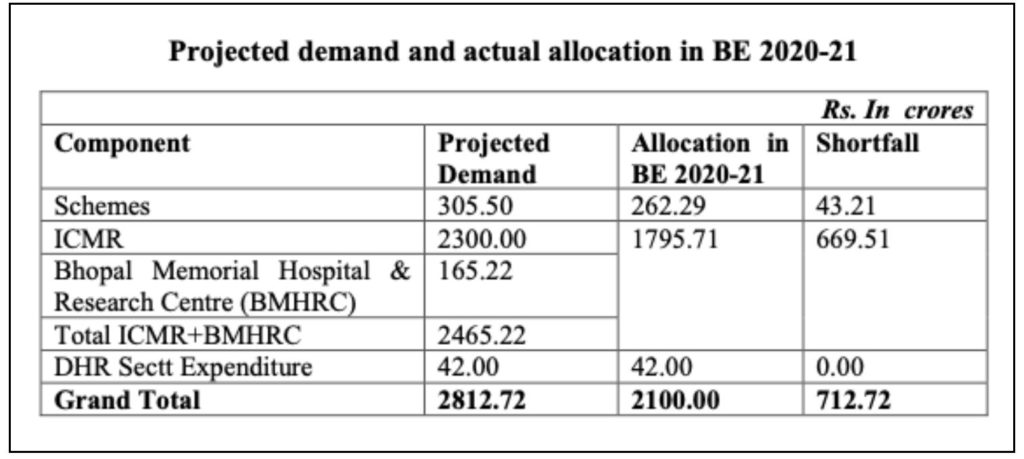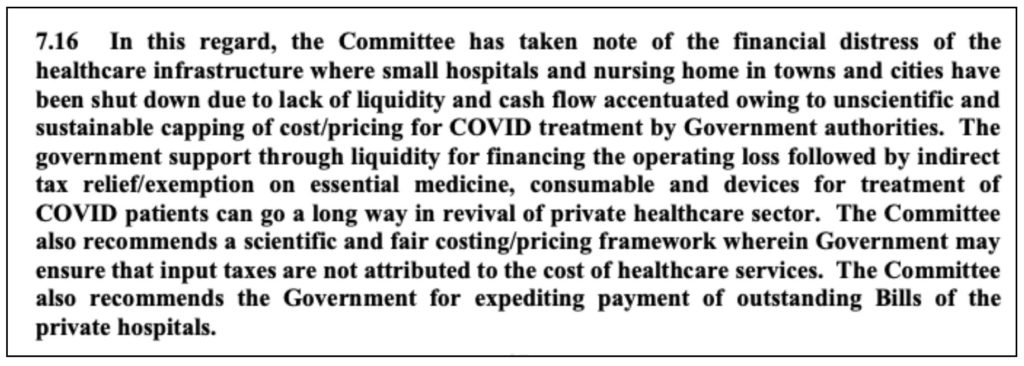Among the first reports on the government’s management of COVID-19, the parliamentary standing committee on Health & Family Welfare submitted a report recently to the Rajya Sabha chairman. Among other things, it highlighted the low investment on healthcare research, greater reliance of rapid antigen tests, high cost of COVID-19 treatment etc. It also appreciated the work of various agencies. Here is a review.
In the previous story, we highlighted few of the key observations made in the Parliamentary Standing Committee’s Report on COVID-19 pandemic in India. These were relating to the lack of health care facilities and the underutilization of the available resources, which could have resulted in the failure of containing the infection during the earlier stages.
In this story we take a look at few other key observations and recommendations made by the Parliamentary Standing Committee in its report submitted recently to the Rajya Sabha chairman.
Committee raises questions over the accuracy & reliability of COVID-19 testing
In the note submitted to the Committee, the Ministry of Health highlighted its success in expanding the network of laboratories to test COVID-19 samples to 2082 from just one laboratory (National Institute of Virology) at the beginning of the pandemic.
The ministry further updated the different tests being conducted to detect COVID-19 infection in the country, which includes – RT-PCR, Rapid Antigen tests, TrueNat & CBNAAT techniques based tests. The testing strategy has evolved over the period of time. Initially, it was limited to international travellers from affected countries , which was later expanded to high risk contacts, health care workers and others.
The expansion of testing criteria was in line with the increase in the testing capabilities across the country. As per Ministry’s data, around 33 thousand tests were conducted in March, which increased to around 3.38 crores tests in October 2020.
While the committee appreciated the efforts of the Government in increasing the testing capability within a short period of time, it raised apprehensions about the accuracy of the tests being conducted, especially the Rapid Antigen tests
It reiterated its opinion that poor contact tracing and less testing in the initial stages could have contributed towards the increase in the number of COVID-19 cases. It stated that while Rapid Antigen test provides faster results, there are questions around the reliability of the same when compared to RT-PCR tests. It observed that large scale use of such tests with low specificity and sensitivity can result in false negatives and can have an impact on containment of COVID-19. Therefore, the committee recommended the Government to ramp up the capabilities to conduct more reliable tests like RT-PCR.
As mentioned by the ministry, available data indicates that the number of tests being conducted across the country has exponentially increased. In fact India ranks second only to USA in terms of the total number of tests conducted. Despite India recording the second highest number of COVID-19 cases, the Cumulative Positivity Rate is among the least in the world. Few of the developed countries like UK & Germany with better and reliable testing strategies have higher positivity rates. However, it has to be noted that the testing strategies vary across the countries with few of the countries following a more focussed strategy. The low positivity rate in India corroborates with the apprehension of the committee regarding the accuracy of the rapid tests and the scope of higher false negatives.
Affordability of COVID-19 treatment and access to Healthcare
In the earlier story, we highlighted the observation made by the Committee regarding the lack of Hospitals & Healthcare facilities in the country, which could have hampered the containment of the infection & treatment of COVID-19 patients.
The committee made multiple observations and recommendations regarding the monetary aspects relating to COVID-19 and Health Infrastructure in India.
Less spending on R&D
As per UIS data (UNESCO Institute of Statistical data), India invested only 0.65% of GDP on Research & Development in 2018. It was lesser than 2017, where in 0.67 % of GDP was invested. Comparatively, Gross Domestic Expenditure on R&D (GERD) of USA is 2.84% of GDP while that of China is 2.19%. India’s GERD is much lower than the World average which is at 1.72%. The Committee expressed concern on the apathy of the government in its low investment on R&D and recommended that the ministry should try and increase it to at least the World average.
The committee has further observed , based on Budgetary allocation that among the various departments involved in scientific research, the allocation for Department of Health Research is among the lowest. Although the Budgetary Allocation for 2020-21 is increased to Rs. 2100 crores compared to Rs. 1900 crores in 2019-20, it is less than the projected demand of over Rs. 2,800 crores.

The committee observed that investment on R&D would help to develop better understanding on the spread of diseases and also to domestically develop diagnostic kits and other equipment which can reduce the reliance on imports. These in turn could help patients reduce their expenditure on treatment.
Exclusion of beneficiaries under AB-PMJAY and other health schemes
The Ministry appraised the Standing committee on Ayushman Bharat Scheme which consists of two components – (i) Creation of 1.5 lakh Health & Wellness Centres (ABHWCs) for providing Comprehensive Health Care (ii) AB-Pradhan Mantri Jan Arogya Yojana (AB-PMJAY) which provided health cover of Rs. 5 lakh per annum per family for secondary and tertiary care hospitalization.
As per update of the CEO of National Health Authority (NHA), free COVID testing and treatment was conducted for PMJAY beneficiaries. The ministry emphasized that access to private hospitals was provided for the beneficiaries of PMJAY at free of cost.
The committee acknowledged the initiatives under the Ayushman Bharat Scheme both in terms of identifying and empanelling Health care facilities as ABHWCs as well as providing comprehensive health care to beneficiaries. However, it raised apprehensions about the reach and inclusion under Ayushman Bharat.

The exclusion meant that many of the eligible from marginalised sections of the society were not able to get the benefit of Ayushman Bharat and hence had to pay out of their pocket for COVID-19 treatment. In few of the cases, they got the support from the schemes of respective state governments. However, this has further added to the burden of the State Governments.
The Committee also highlights the fact that, lack of suitable facilities in the Public Health Care centers and hospitals meant that many were forced to rely on Private hospitals for COVID-19 treatment. This adds to the financial burden of the effected families.

Need for Scientific approach to fix pricing of COVID-19 treatment
The Standing committee took cognizance of the affordability of COVID-19 treatment. It observed that many private healthcare facilities have charged higher prices for COVID-19 treatment, which has created financial burden and made treatment inaccessible.
Meanwhile, the government’s efforts to cap the pricing of COVID-19 treatment had an impact on the hospitals who had to take up the additional burden of infrastructure for COVID-19 treatment and do not have scope to meet this expenditure with the capping limits set.
Hence the committee has recommended that the government come up with a more scientific approach in devising a sustainable cost model that is affordable to the people and also is not a burden on the private hospitals that are providing COVID-19 treatment.

Recommendations on AYUSH and other aspects
The Standing Committee dwelled into many areas regarding COVID-19 pandemic in the country. Few of the other key observations and recommendations include:
- Multiple guidelines issues by the Ministry during the course of COVID-19 outbreak in the country has caused ambiguity in interpretation. The contradictory guidelines have created a confusion among public and has aided to the spread of COVID-19 , which could have been averted by a better communication to the public.
- The Committee has advised the Ministry to issues clear guidelines on the safe usage of prescribed drugs. It recommended that only drugs with reliable data and research to be used in treatment of COVID-19 especially in cases of co-morbidities.
- While appreciating the involvement in research and assistance under AYUSH, the committee raised concern over misleading products being advertised under the approval of AYUSH ministry.

- The committee recognizes the rise in mental health issues during the lockdown among the masses as well as depression among the front line workers. The committee has requested to invest in mental health research and to create more awareness to remove the stigma attached to mental health.
The committee has further highlighted the plight of women during COVID-19 and the assistance required to reduce the possibility of atrocities against women.
Overall, the Standing Committee has appreciated the efforts of Government, MOHFW and ICMR in their efforts to mitigate the impact of the unprecedented pandemic. However, it has also opined that a more proactive approach in the initial stages and better health care system could have helped control the pandemic in the early stage.
Featured Image: Investment on Healthcare Research


